How to rewrite guest author name using custom fields in WordPress
Apr 20, 2025 am 07:00 AMDo you want to rewrite your guest author's name using a custom field in WordPress?
If you accept guest posts on your WordPress blog, you may not want to create a new user account for every guest author on your website.
In this article, we will show you how to easily rewrite guest authors in WordPress using custom fields without creating user accounts.

Method 1. Add guest author information using WordPress plugin
For this method, we will use the WordPress plugin. Using plugins can make the process easier, and we recommend it to all users.
First, you need to install and activate the Guest Author plugin. For more details, see our step-by-step guide on how to install WordPress plug-ins.
Once activated, you need to edit the blog post you want to pay tribute to the guest author.
On the editing screen, you will notice a new tab labeled "Author" under the Posts panel on the right.
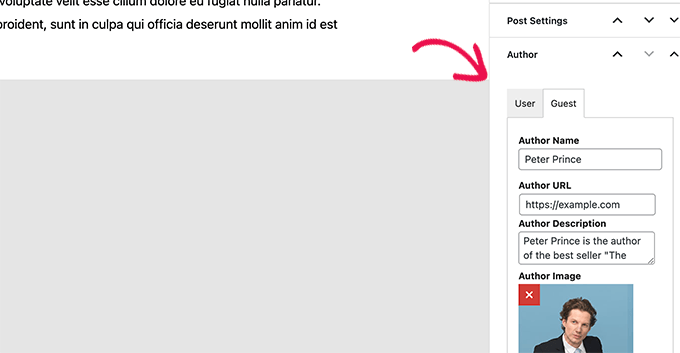
From here, switch to the Visitors tab and enter the visitor author information, such as the author name, website, biographical description, and images.
After that, you can save or post a post and preview it in your browser. This is how it looks on our demo website.
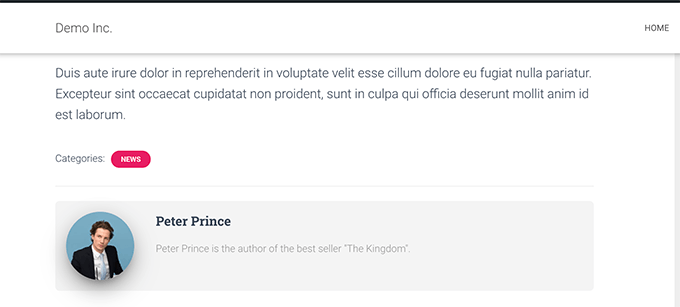
Method 2. Add a guest author in WordPress using custom fields
This method requires you to add some code to your WordPress theme file. If you haven't done this before, check out our guide on how to add custom code snippets in WordPress.
We will use a WordPress feature called Custom Fields. Custom fields allow you to add custom metadata to content, which you can then display in a WordPress theme by adding some code.
To learn more about custom fields, you may want to check out our article on WordPress Beginner Custom Fields.
In this tutorial, we first save the guest author name as a custom field in WordPress. After that, we will use the code snippet to replace the author name with the guest author name that can be used as custom metadata.
First, you need to edit the blog post where you want to display the guest author's name.
On the editing screen, click the three-dot menu in the upper right corner of the screen and select Preferences.
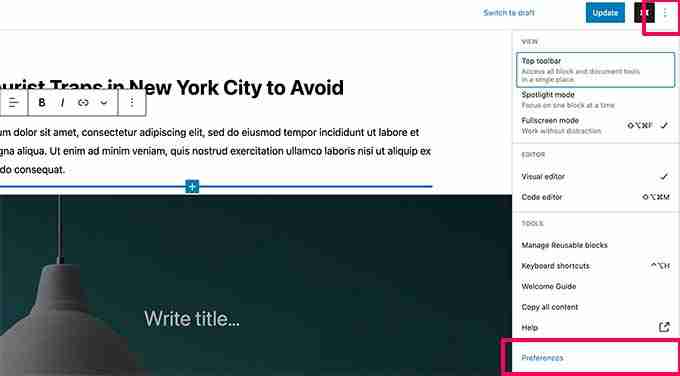
This will pop up the Block Editor settings popup.
From here, you need to switch to the Panel tab and open the Custom Fields option.
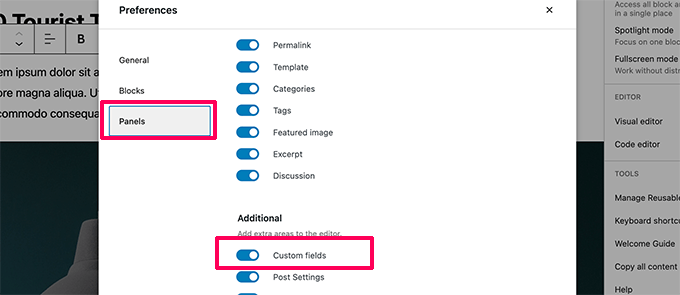
You can now close the Preferences pop-up.
After that, you will notice a new custom field box below the editor.

Now you need to click the "Enter New" link to create a custom field for the guest author name.
First enter "guest-author" as the name of the custom field. Then in the Value field, just enter the guest author's name.
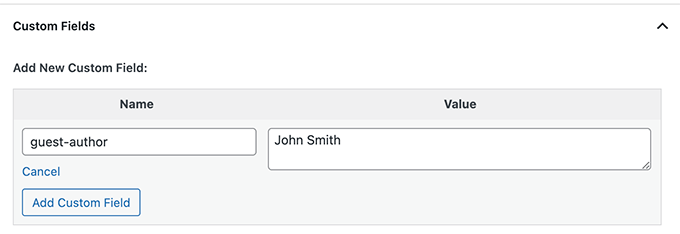
Continue and click the "Add Custom Field" button to save.
After that, don't forget to update or save your blog post.
Now that we have saved the guest author information as a custom field, the next step is to display it on your website.
To do this, you need to copy and paste the following code into the functions.php file of the theme or into the site-specific plugin.

We hope this article helps you easily rewrite the author's name and replace it with the guest author's name in WordPress. You may also want to check out other WordPress tips, tips, and tips, or check out our guide on using user-generated content to grow your WordPress blog.
The above is the detailed content of How to rewrite guest author name using custom fields in WordPress. For more information, please follow other related articles on the PHP Chinese website!

Hot AI Tools

Undress AI Tool
Undress images for free

Undresser.AI Undress
AI-powered app for creating realistic nude photos

AI Clothes Remover
Online AI tool for removing clothes from photos.

Clothoff.io
AI clothes remover

Video Face Swap
Swap faces in any video effortlessly with our completely free AI face swap tool!

Hot Article

Hot Tools

Notepad++7.3.1
Easy-to-use and free code editor

SublimeText3 Chinese version
Chinese version, very easy to use

Zend Studio 13.0.1
Powerful PHP integrated development environment

Dreamweaver CS6
Visual web development tools

SublimeText3 Mac version
God-level code editing software (SublimeText3)

Hot Topics
 The latest version of Digital Currency Exchange 2025 Bitcoin Exchange APP official website address
Jul 04, 2025 pm 01:30 PM
The latest version of Digital Currency Exchange 2025 Bitcoin Exchange APP official website address
Jul 04, 2025 pm 01:30 PM
The latest version of Digital Currency Exchange 2025 is a world-leading digital asset trading application, committed to providing users with secure, stable and convenient trading services for mainstream digital currencies such as Bitcoin and Ethereum. Its simple and intuitive operation interface and powerful functional modules make it easy for both novices and senior traders to get started.
 Ethereum Classic (ETC) price outlook: 2025, 2026, 2027-2030 analysis
Jul 03, 2025 pm 01:57 PM
Ethereum Classic (ETC) price outlook: 2025, 2026, 2027-2030 analysis
Jul 03, 2025 pm 01:57 PM
As an important digital asset hard forked from the original Ethereum blockchain, Ethereum Classic (ETC) has always been the focus of market attention. After experiencing ups and downs in early development and multiple technological iterations, ETC still occupies a place in the global cryptocurrency market with its unique decentralized spirit and smart contract platform functions. There are many factors that affect ETC prices, including but not limited to macro trends in the entire cryptocurrency market, ETC’s own network upgrades and security, community activity, changes in regulatory environments, and the attitudes of institutional investors.
 Ethereum (ETH) price estimate: 2025, 2026, 2027-2030 forecast
Jul 03, 2025 pm 01:51 PM
Ethereum (ETH) price estimate: 2025, 2026, 2027-2030 forecast
Jul 03, 2025 pm 01:51 PM
Ethereum, as one of the blockchain platforms with leading market value and the most active ecosystem, has attracted much attention. It is not only a digital asset, but also the cornerstone of innovation fields such as decentralized applications, smart contracts, decentralized finance (DeFi) and non-fungible tokens (NFT). Predicting its future price trend is a complex process, affected by the interweaving of multiple factors such as technological development, macroeconomic environment, regulatory policies, market sentiment and network itself upgrade.
 Dogecoin (DOGE) future price estimate: Market analysis from 2025 to 2030
Jul 03, 2025 pm 01:54 PM
Dogecoin (DOGE) future price estimate: Market analysis from 2025 to 2030
Jul 03, 2025 pm 01:54 PM
Dogecoin (DOGE), a digital asset originating from the Internet subculture, has occupied a place in the crypto market with its unique community culture and wide popularity. For many market participants, predicting their price movements over a specific time period in the future is challenging but attractive. This article aims to deeply analyze the key factors that may affect Dogecoin’s market value from 2025 to 2030 and explore its potential development path.
 Binance Exchange Official Website Portal Binance Official Website Portal
Jul 04, 2025 pm 11:06 PM
Binance Exchange Official Website Portal Binance Official Website Portal
Jul 04, 2025 pm 11:06 PM
The latest version of Binance is v2.102.5, and the update tutorial is: 1. Click the download link in the web page; 2. Authorize the installation permission of "Allow installation from unknown sources"; 3. Find the downloaded APk and click to install; 4. Click the installed application to open it.
 High return expectations for cryptocurrency tokens in July 2025: hype or reality?
Jul 04, 2025 pm 08:42 PM
High return expectations for cryptocurrency tokens in July 2025: hype or reality?
Jul 04, 2025 pm 08:42 PM
As July 2025 approaches, the crypto market is hotly discussing which tokens may bring high returns. Are names like Pi, PEPE and FloppyPepe really worth the risky investment? Potential cryptocurrencies worth paying attention to in July 2025: virtual fire or real gold? As mid-2025, the heat of discussions on high-yield crypto assets continues to heat up. Bitcoin trends and "altcoin season" expectations have attracted investors' attention. Do tokens like PiNetwork, PEPE and FloppyPepe have the potential to bring considerable investment returns? Let's analyze its prospects one by one. Altcoin Market: Can July get what it wants? Against the backdrop of Bitcoin’s expected record of historical highs, the “altcoin season” seems to be brewing. Back
 Binance Exchange app Android version Binance Exchange Chinese version installation package direct
Jul 04, 2025 pm 10:54 PM
Binance Exchange app Android version Binance Exchange Chinese version installation package direct
Jul 04, 2025 pm 10:54 PM
The latest version of Binance is v2.102.5, and the update tutorial is: 1. Click the download link in the web page; 2. Authorize the installation permission of "Allow installation from unknown sources"; 3. Find the downloaded APk and click to install; 4. Click the installed application to open it.
 Binance official website link Binance official website entrance address
Jul 04, 2025 pm 11:18 PM
Binance official website link Binance official website entrance address
Jul 04, 2025 pm 11:18 PM
The latest version of Binance is 2.101.8, and the update tutorial is: 1. Click the download link in the web page; 2. Authorize the installation permission of "Allow installation from unknown sources"; 3. Find the downloaded APk and click to install; 4. Click the installed application to open it.






